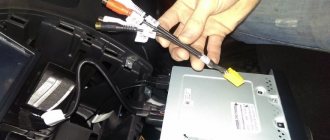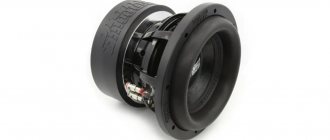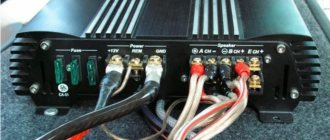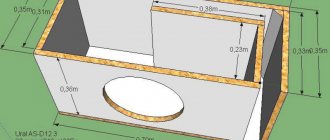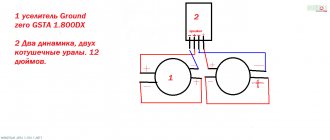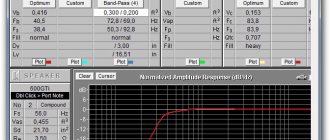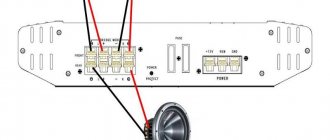In electrodynamic heads that are used in subwoofers, there are models equipped with two voice coils. Such speakers are no different in appearance from ordinary speakers, and their only difference is the additional terminals for connecting the second winding. The material, number of turns and electrical parameters of the sound windings are the same. Usually subwoofers have a winding resistance of 4 or 2 ohms, but there are heads with other coils.
It happens that one subwoofer model is offered in two versions: with one sound winding or with two.
Subs with one coil 2 and 4 Ohm
1 sub with two and one 4 ohm coils
1 sub with two 2 ohm coils
3 subwoofers with two and one 4 ohm coils
4 subwoofers with two 4 ohm coils
3 subwoofers with two 2 ohm coils
4 subwoofers with two 4 ohm coils
4 subwoofers with two coils of 2 ohms, resistance 1 ohm
4 subwoofers with two 2 ohm coils
4 subwoofers with two 4 ohm coils
4 subwoofers with one 8 ohm coil
2 subwoofers with one 8 ohm coil
admin
Comments 70
Where do you get the plus minus when connecting 3 subs with one coil?
And so the question is, I didn’t find a diagram for you, a custom sub former Def Bons 123, the coils were converted to 0.50.5 ohm resistance, monoblock machete m2000d, how to connect
it in one ohm? A diagram, at least in words. I would be very happy, I’m afraid I’ll burn it, it’s a little expensive.
There is a Mystery MO12S two-reel sub, not a monoblock MR1.300, also a Mystery. What is the circuit for it so that it works from a two ohm amplifier? If I understand correctly, then according to the ten scheme?
author, excuse me, but parallel switching of a subwoofer with two coils is four ohms, isn't there any ohm? After all, they divide and then meet, it turns out 4:4 = 1 Ohm. Am I wrong otherwise?
How to connect a monoblock in 1 ohm
It may be easier to connect a single-coil subwoofer to a monoblock or multi-channel amplifier. It's a completely different matter if the subwoofer has two voice coils or two or more of them.
A two-coil subwoofer, as well as two, three or more subwoofers, can be connected in four ways: each coil separately, parallel connection of coils, serial and combined.
What each of these subwoofer switching options gives is, first of all, versatility, different capabilities. Let's consider each option separately. But first of all, you need to understand what happens when the coils are connected in parallel or in series.
When the coils are connected in parallel, the total resistance, roughly speaking, becomes half as much. For example: if we connect two 4 Ohm coils in parallel, we get a total resistance of 2 Ohms, if we connect two 2 Ohm coils, we get a total resistance of 1 Ohm.
The opposite effect occurs with a series connection. When connecting two 4 Ohm coils in series, we get a resistance of 8 Ohms, when connecting two 2 Ohm coils, we get 4 Ohms. etc.
Connecting each coil separately . This option allows you to connect a powerful two-coil subwoofer to a less powerful four-channel amplifier if it is not possible or not possible to purchase a powerful monoblock. Naturally, the resistance of the coils must correspond to the operating load of the amplifier in a bridge connection and the GAIN controls must be at the same level.
Parallel connection of coils - subwoofers.
As described above, when connected in parallel, the resistance is halved, allowing the amplifier, operating at a lower load, to deliver more power.
But as they say, “if it leaves somewhere, it will definitely arrive somewhere.” In this case, this is true, only on the contrary, the power has increased, and the amplifier’s control over the subwoofer has decreased, as a result of which the bass becomes smeared.
Series connection of coils . If the amplifier is powerful, why not, increase the impedance (resistance) and get a more developed bass.
I would also like to add that if the resistance of the connected coils exceeds the permissible load of the amplifier, this is not at all scary, it’s just that the output power of the amplifier will be less.
Let's say an amplifier with a declared operation for a load of 4 ohms produces 500 watts, and with a load of 8 ohms, for example, it will produce 350 watts.
Combined connection . Subwoofers are coils that are simultaneously connected in serial and parallel connections for switching to a specific load. There are a great many connection options, it all depends on the number of subwoofer speakers, the resistance of the subwoofer voice coils and the capabilities of the amplifier.
“Every little one knows, black is a minus, red is a plus!”
Connecting the subwoofer to the radio
It is necessary to connect the subwoofer to the radio only through an amplifier. Since the built-in power of the radio is not enough for the subwoofer to work properly, you will not get normal bass. The connection chain is simple: radio-amplifier-subwoofer. The radio transmits the signal to the amplifier. The amplifier, in turn, amplifies this signal and sends it to the subwoofer.
What is an amplifier for?
The amplifier is used to increase the volume headroom, reduce distortion and improve the sound quality of music. The built-in amplifier of the radio is not enough to drive a heavy low-frequency speaker, which will cause large distortions, the volume level will be low and, with a high probability, the subwoofer may fail or simply “burn out.”
If you have an active subwoofer, then you will not need an additional amplifier, because it is already built into the subwoofer housing (more about active subwoofers). For a passive subwoofer you will have to choose an amplifier (read how to do this correctly on this page).
How to connect a subwoofer to an amplifier
Single channel connection
Connecting a subwoofer to an amplifier is not difficult; just connect the amplifier's audio output jack to the subwoofer coil or coils using speaker wires.
The wires should not be thin. In most cases, choose copper wiring with a cross-section of 4 mm and there will be no problems.
Connecting speaker wires
This subwoofer connection diagram is suitable for one channel of an amplifier or monoblock.
Monoblock is a single-channel amplifier designed specifically for subwoofers.
Connecting to a subwoofer via terminal block
Setting up the car's multimedia system
Connecting to a subwoofer directly
Connecting a subwoofer with a bridge
- In the case of using a multi-channel amplifier, the sub can be connected to two channels simultaneously, using the minus of one and the plus of the other, this connection is called bridged, with this method the power output by the amplifier increases significantly (see the specifications for specific numbers).
- So you can connect a subwoofer to a two or four channel amplifier, using 2 channels for acoustics, and the remaining 2 for the subwoofer.
- To connect a subwoofer with a bridge, make sure that your amplifier supports this feature.
- If you connect a low-frequency speaker to an amplifier by changing the polarity, that is, connect the plus of the subwoofer to the minus of the amplifier output and vice versa, then the speaker will work in antiphase, there is nothing wrong with that, sometimes such a connection is used intentionally if the amplifier does not have phase adjustment (more about adjustment phases).
Connecting the subwoofer coils
The technical documentation for the subwoofer states the resistance of its coils (1 Ohm, 2 Ohm, 4 Ohm, rarely 0.
5 Ohms), and the technical documentation of the amplifier indicates what resistances it can work with; this information is needed so that you correctly and effectively connect the subwoofer to the amplifier.
The lower the resistance of the sub, the more power the amplifier will produce, provided that it can operate at this resistance. A subwoofer speaker may have several coils (1 or 2, rarely 4).
When the coils are connected in series, the resistance increases, while in parallel it decreases. If you don't want to learn definitions and count fractions, just save this cheat sheet (parallel and serial connections).
How much ohm to connect the subwoofer
The higher the resistance, the better the sound quality; the lower, the more power the amplifier delivers. If you need a lot of loud bass, then turn it to the minimum that the amplifier can provide, and if the overall sound quality of the system comes first, then it is 2 Ohms or 4 Ohms, depending on the power output.
Video on how to connect 2 subwoofers or more. Subwoofer connection diagram 2x2 Ohm, 4x4 Ohm, 1x1 Ohm. Serial connection of speakers. Parallel connection of speakers. Basic principles.
- Happy connections!
- I decided to post some subwoofer connection diagrams... someone might need it...
see also
Instructions for setting up a 4-channel amplifier
Generally, there are three types of amplifier settings you need to know. All of them are given below.
Amplifier setup for four speakers but no subwoofer
So:
- The amplifier's filter/crossover is turned off, and only the speakers reproduce the entire frequency range.
- We put the Crossover Selector switch in the Flat position.
- Level is set to position 8V.
- Bass Boost is set to 0dB.
- Now you will need to increase the volume on the car radio, but not more than 90%.
- The equalizer, if it is not configured, is set to position 0 according to music styles.
- Connect the amplifier and slowly turn the Level clockwise until the end.
Setting up an amplifier for a subwoofer and speakers
So:
- Crossover Selector Front on the amplifier is set to the HP position.
- Phi Pass is set to 60Hz-80Hz.
- Crossover Selector Rear is installed on LP.
- Love Pass is adjustable in the frequency range 65Hz-85Hz.
- Level is set to 0.
- Bass Boost is also at 0dB.
- As with the above-described Level setting, rotate it all the way, but adjust the sensitivity.
Tuning for local gain
So:
- Crossover The selector is set to Flat.
- Turn on HP for tweeters.
- Turn the Hi PASS control to the 250Hz position.
- We adjust the amplifier using the Level rotator.
Note. If the car radio in the car is a new version, adjusting the amplifier may not be necessary. These radios already have automatic Bass Boost settings. If this is the case, then you will just need to adjust the Level rotator.
How to connect a subwoofer in a car
“Every little one knows, black is a minus, red is a plus!”
Connecting the subwoofer to the radio
It is necessary to connect the subwoofer to the radio only through an amplifier. Since the built-in power of the radio is not enough for the subwoofer to work properly, you will not get normal bass. The connection chain is simple: radio-amplifier-subwoofer. The radio transmits the signal to the amplifier. The amplifier, in turn, amplifies this signal and sends it to the subwoofer.
What is an amplifier for?
The amplifier is used to increase the volume headroom, reduce distortion and improve the sound quality of music. The built-in amplifier of the radio is not enough to drive a heavy low-frequency speaker, which will cause large distortions, the volume level will be low and, with a high probability, the subwoofer may fail or simply “burn out.”
If you have an active subwoofer, then you will not need an additional amplifier, because it is already built into the subwoofer housing (more about active subwoofers). For a passive subwoofer you will have to choose an amplifier (read how to do this correctly on this page).
How to connect a subwoofer to an amplifier
Single channel connection
Connecting a subwoofer to an amplifier is not difficult; just connect the amplifier's audio output jack to the subwoofer coil or coils using speaker wires.
The wires should not be thin. In most cases, choose copper wiring with a cross-section of 4.2 square meters. mm and there will be no problems.
Connecting speaker wires
This subwoofer connection diagram is suitable for one channel of an amplifier or monoblock. If a 1-channel amplifier has two pluses and minuses, then don’t get lost, these pairs are simply paralleled for ease of switching. And it makes no difference which of the pluses and minuses the corresponding wire is connected to.
Monoblock is a single-channel amplifier designed specifically for subwoofers.
Connecting to a subwoofer via a terminal block Connecting to a subwoofer directly
Connecting a subwoofer with a bridge
- In the case of using a multi-channel amplifier, the sub can be connected to two channels simultaneously, using the minus of one and the plus of the other, this connection is called bridged, with this method the power output by the amplifier increases significantly (see the specifications for specific numbers).
- So you can connect a subwoofer to a two or four channel amplifier, using 2 channels for acoustics, and the remaining 2 for the subwoofer.
- To connect a subwoofer with a bridge, make sure that your amplifier supports this feature.
- If you connect a low-frequency speaker to an amplifier by changing the polarity, that is, connect the plus of the subwoofer to the minus of the amplifier output and vice versa, then the speaker will work in antiphase, there is nothing wrong with that, sometimes such a connection is used intentionally if the amplifier does not have phase adjustment (more about adjustment phases).
Connecting the subwoofer coils
The technical documentation for the subwoofer states the resistance of its coils (1 Ohm, 2 Ohm, 4 Ohm, rarely 0.
5 Ohms), and the technical documentation of the amplifier indicates what resistances it can work with; this information is needed so that you correctly and effectively connect the subwoofer to the amplifier.
The lower the resistance of the sub, the more power the amplifier will produce, provided that it can operate at this resistance. A subwoofer speaker may have several coils (1 or 2, rarely 4).
When the coils are connected in series, the resistance increases, while in parallel it decreases. If you don't want to learn definitions and count fractions, just save this cheat sheet (parallel and serial connections).
Connection options
How many ohms should I connect the subwoofer to?
The higher the resistance, the better the sound quality; the lower, the more power the amplifier delivers. If you need a lot of loud bass, then turn it to the minimum that the amplifier can provide, and if the overall sound quality of the system comes first, then it is 2 Ohms or 4 Ohms, depending on the power output.
Video on how to connect 2 subwoofers or more. Subwoofer connection diagram 2x2 Ohm, 4x4 Ohm, 1x1 Ohm. Serial connection of speakers. Parallel connection of speakers. Basic principles.
Happy connections!
Selecting an active subwoofer
Connecting the front to a 4-channel amplifier
How to connect an active subwoofer to a car
You can purchase an active subwoofer in almost any store that sells car parts. However, you need to keep in mind that there is a huge selection of such devices:
- Passive.
- Active.
- Separate.
- Corpus.
And this is not the whole list. Therefore, many beginners have some problems when choosing a subwoofer. Before going to the store to purchase, you need to do the following:
Check out a real speaker system
That is, you need to pay attention to what its bass is like. The fact is that a subwoofer can only enhance the bass, but not make it normal
In general, before you start choosing a subwoofer, you should decide which type will fit in the car:
There are separate subwoofers that can be placed on the rear parcel shelf or back of the rear seat.
- Corpus. They are placed in various housings available in the car.
- Passive subwoofers. These are the most primitive subwoofers. That is, they are a bare speaker that can only work due to an additional sound amplifier.
- Active. In its properties it resembles a passive subwoofer. However, it is equipped with its own amplifier, which has a low frequency. It is more popular compared to passive ones. The cost of a good and high-quality subwoofer is quite high, so you should think carefully before choosing one.
You should not pay attention to what business card the subwoofers have. After all, every company says that its device is the best, while clouding the advertising of other companies
But you should be guided not by advertising, but by your own experience. You should only look at the reputation of the company and the appearance of the product being purchased.
Methods for connecting subwoofers | Useful car audio
June 17, 2019
// Useful car audio
One of the most important components in audio systems is the subwoofer.
A subwoofer is a speaker designed to reproduce low frequencies that are at the lower sensitivity threshold of the human ear. The term "Subwoofer" is used to describe a system with a low-frequency driver housed in a separate housing.
Terminology
- Maximum sound pressure. Maximum subwoofer volume.
- Frequency range (Hz). The frequency range of the subwoofer can be divided into the area of deep bass 20-40 Hz, medium bass 40-80 Hz, high bass (midbass) 80-160 Hz.
- Sensitivity (dB). The more sensitive the dynamics, the less the amplifier is loaded, the greater the sound pressure it produces at the same power.
- The larger the diffuser size, and therefore the area, the more powerful the bass.
Connecting a subwoofer
Proper connection of a subwoofer with two coils is very important, especially when the amplifier is not capable of operating in a low-impedance load or is too powerful in relation to the speaker. Do not expose the amplifier to loads lower than those permitted by the manufacturer.
The table below shows the connection resistance options.
Connection methods
Parallel connection of speakers Series connection of speakers
| Methods for connecting subwoofers | |||
| Number of speakers | Voice coil | Total impedance | Connection diagram |
| 1 speaker | 4+4 Ohm | 2 ohm | |
| 2+2 Ohm | 1 ohm | ||
| 1+1 Ohm | 0.5 Ohm | ||
| 2 speakers | 4+4 Ohm | 1 ohm | |
| 2+2 Ohm | 0.5 Ohm | ||
| 1+1 Ohm | 0.25 Ohm | ||
| 1 speaker | 4+4 Ohm | 8 ohm | |
| 2+2 Ohm | 4 ohm | ||
| 1+1 Ohm | 2 ohm | ||
| 2 speakers | 4+4 Ohm | 4 ohm | |
| 2+2 Ohm | 2 ohm | ||
| 1+1 Ohm | 1 ohm |
We pull the wires to the speaker system
Let's talk about the features of connecting amplifiers and speaker systems. As we have already mentioned several times, for this it is necessary to use special wires. They can be pulled through without fear of interference from other electronics in the car. But on crossovers it’s quite possible to catch acoustic interference, so the cable should be placed as far as possible from sources of possible interference.
There is only one difficulty. We are talking about pulling the cable through the door. So how do you connect an amplifier to speakers? In most cases, manufacturers do not forget about consumers, leaving special connectors for laying cable channels or embedding rubber couplings under them. But often such gifts from the auto industry cannot be expected, and therefore additional holes have to be drilled.
Do not forget to remove the terminals from the battery before carrying out work!
Where to connect the wires on the amplifier, radio or subwoofer
On the back of the radio or amplifier there are usually two separate ports - for connecting the power part and acoustics. There may be connectors of different shapes. Terminals for bolted connections are more reliable; in them, the wires are attracted by bolts with contact pads put on them. They need to be tightened periodically so that they do not become loose from shaking.
Example of connection to an amplifier. Same thing for the radio
We connect the cable from the battery to the terminal labeled +12 V. The negative is connected to GND or “–”. There is another terminal in the power block - RMT or can also be labeled as REM. This is the input for connecting the control cable. It serves to simultaneously turn on the amplifier and radio.
Connecting power cables to an active subwoofer
The subwoofer has a similar connector for connecting power cables. In the photo on the left he is below. There is the same input, labeled +12 V. We connect the cable from the battery here. The GND socket is the negative from the case, and the REM socket is for connecting control. As you can see, the power on all active parts of the system (radio, amplifier and subwoofer) is connected in the same way.
